Comprehensive Report: Current Infectious Disease Trends and Analysis
VerifiedAdded on 2023/01/13
|6
|880
|49
Report
AI Summary
This report provides an analysis of infectious disease trends, focusing on epidemiology, outbreak, incidence, and prevalence. It defines key terms and examines the role of nursing within epidemiology, highlighting how nurses contribute to patient care and infection control through preventive measures. The report evaluates current infectious diseases at local, state, and national levels, including outbreaks of influenza and coronavirus, and associates these diseases with Healthy People 2020 objectives. Furthermore, it explores evidence-based practices aimed at reducing infectious diseases, such as preventive measures for HIV and promoting public health education. The report concludes by emphasizing the importance of preventive measures to combat the spread of infectious diseases, supported by the provided references.
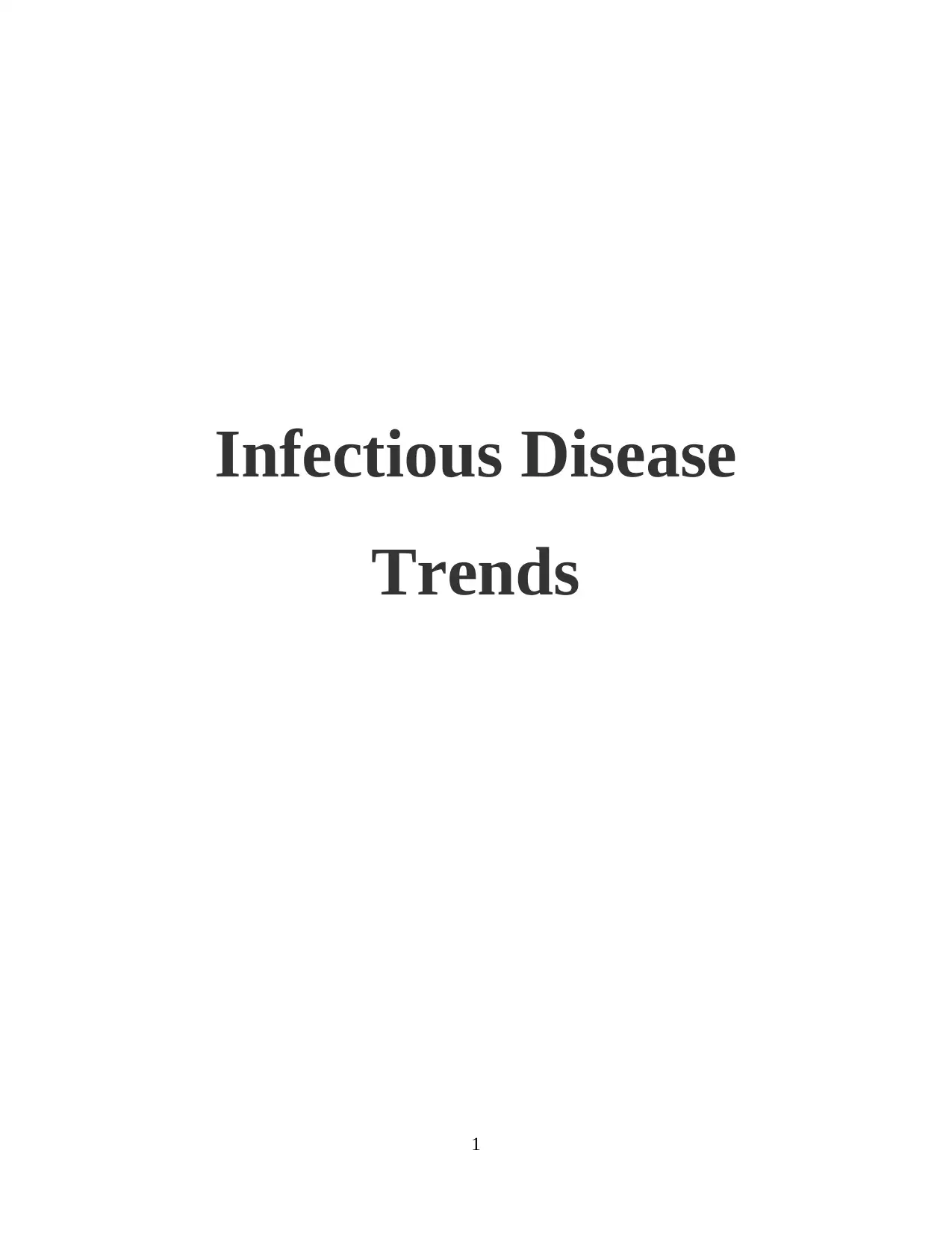
Infectious Disease
Trends
1
Trends
1
Paraphrase This Document
Need a fresh take? Get an instant paraphrase of this document with our AI Paraphraser
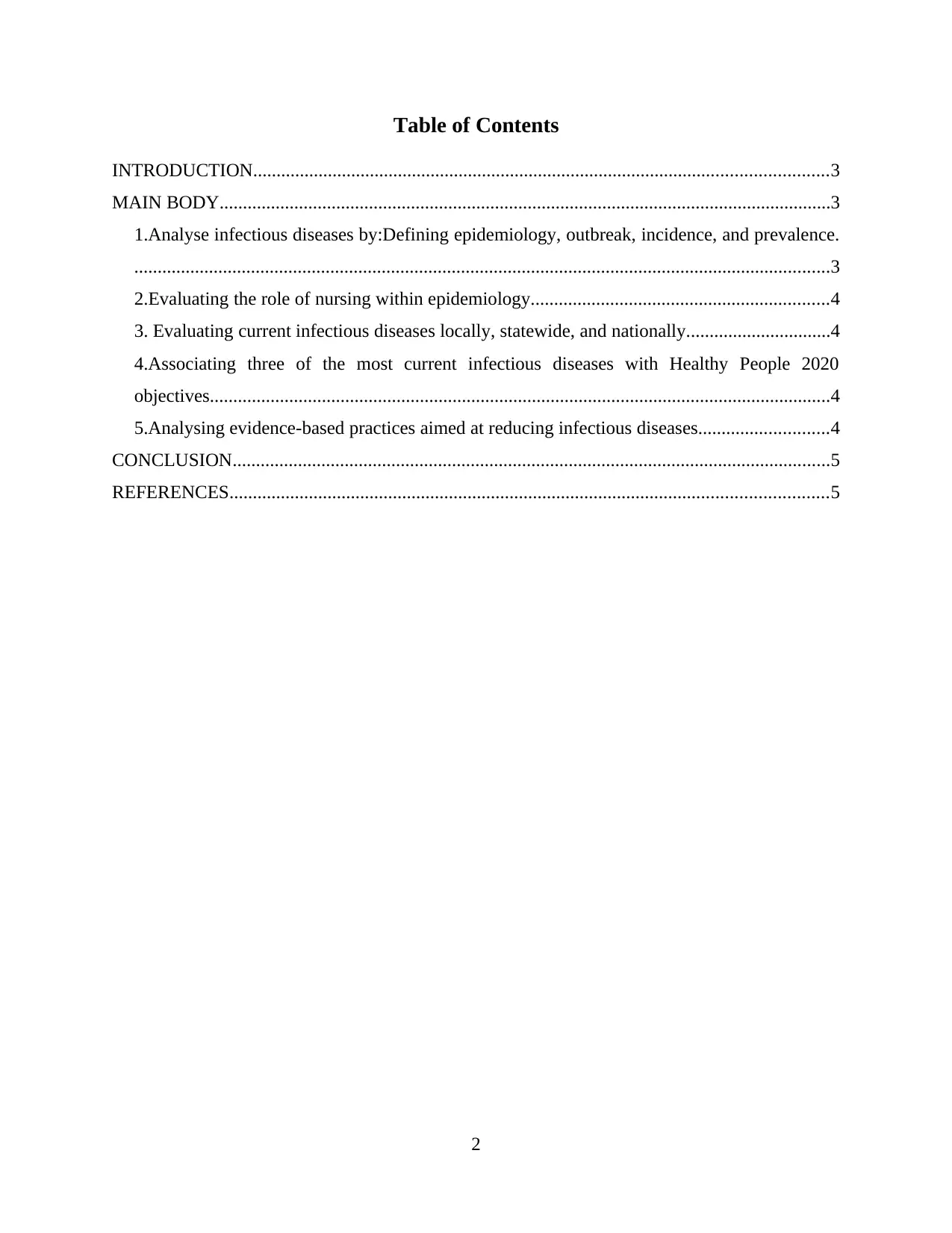
Table of Contents
INTRODUCTION...........................................................................................................................3
MAIN BODY...................................................................................................................................3
1.Analyse infectious diseases by:Defining epidemiology, outbreak, incidence, and prevalence.
.....................................................................................................................................................3
2.Evaluating the role of nursing within epidemiology................................................................4
3. Evaluating current infectious diseases locally, statewide, and nationally...............................4
4.Associating three of the most current infectious diseases with Healthy People 2020
objectives.....................................................................................................................................4
5.Analysing evidence-based practices aimed at reducing infectious diseases............................4
CONCLUSION................................................................................................................................5
REFERENCES................................................................................................................................5
2
INTRODUCTION...........................................................................................................................3
MAIN BODY...................................................................................................................................3
1.Analyse infectious diseases by:Defining epidemiology, outbreak, incidence, and prevalence.
.....................................................................................................................................................3
2.Evaluating the role of nursing within epidemiology................................................................4
3. Evaluating current infectious diseases locally, statewide, and nationally...............................4
4.Associating three of the most current infectious diseases with Healthy People 2020
objectives.....................................................................................................................................4
5.Analysing evidence-based practices aimed at reducing infectious diseases............................4
CONCLUSION................................................................................................................................5
REFERENCES................................................................................................................................5
2
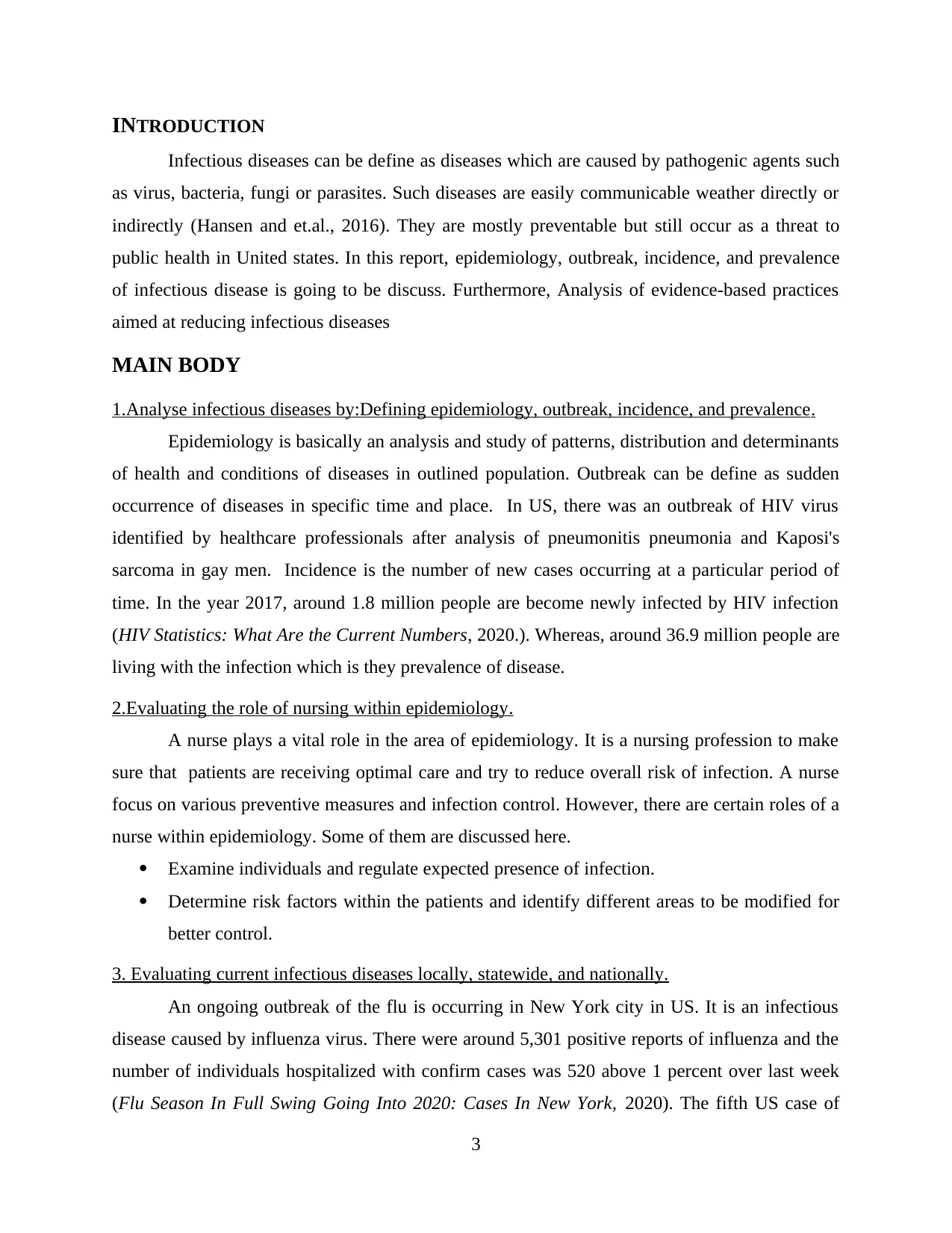
INTRODUCTION
Infectious diseases can be define as diseases which are caused by pathogenic agents such
as virus, bacteria, fungi or parasites. Such diseases are easily communicable weather directly or
indirectly (Hansen and et.al., 2016). They are mostly preventable but still occur as a threat to
public health in United states. In this report, epidemiology, outbreak, incidence, and prevalence
of infectious disease is going to be discuss. Furthermore, Analysis of evidence-based practices
aimed at reducing infectious diseases
MAIN BODY
1.Analyse infectious diseases by:Defining epidemiology, outbreak, incidence, and prevalence.
Epidemiology is basically an analysis and study of patterns, distribution and determinants
of health and conditions of diseases in outlined population. Outbreak can be define as sudden
occurrence of diseases in specific time and place. In US, there was an outbreak of HIV virus
identified by healthcare professionals after analysis of pneumonitis pneumonia and Kaposi's
sarcoma in gay men. Incidence is the number of new cases occurring at a particular period of
time. In the year 2017, around 1.8 million people are become newly infected by HIV infection
(HIV Statistics: What Are the Current Numbers, 2020.). Whereas, around 36.9 million people are
living with the infection which is they prevalence of disease.
2.Evaluating the role of nursing within epidemiology.
A nurse plays a vital role in the area of epidemiology. It is a nursing profession to make
sure that patients are receiving optimal care and try to reduce overall risk of infection. A nurse
focus on various preventive measures and infection control. However, there are certain roles of a
nurse within epidemiology. Some of them are discussed here.
Examine individuals and regulate expected presence of infection.
Determine risk factors within the patients and identify different areas to be modified for
better control.
3. Evaluating current infectious diseases locally, statewide, and nationally.
An ongoing outbreak of the flu is occurring in New York city in US. It is an infectious
disease caused by influenza virus. There were around 5,301 positive reports of influenza and the
number of individuals hospitalized with confirm cases was 520 above 1 percent over last week
(Flu Season In Full Swing Going Into 2020: Cases In New York, 2020). The fifth US case of
3
Infectious diseases can be define as diseases which are caused by pathogenic agents such
as virus, bacteria, fungi or parasites. Such diseases are easily communicable weather directly or
indirectly (Hansen and et.al., 2016). They are mostly preventable but still occur as a threat to
public health in United states. In this report, epidemiology, outbreak, incidence, and prevalence
of infectious disease is going to be discuss. Furthermore, Analysis of evidence-based practices
aimed at reducing infectious diseases
MAIN BODY
1.Analyse infectious diseases by:Defining epidemiology, outbreak, incidence, and prevalence.
Epidemiology is basically an analysis and study of patterns, distribution and determinants
of health and conditions of diseases in outlined population. Outbreak can be define as sudden
occurrence of diseases in specific time and place. In US, there was an outbreak of HIV virus
identified by healthcare professionals after analysis of pneumonitis pneumonia and Kaposi's
sarcoma in gay men. Incidence is the number of new cases occurring at a particular period of
time. In the year 2017, around 1.8 million people are become newly infected by HIV infection
(HIV Statistics: What Are the Current Numbers, 2020.). Whereas, around 36.9 million people are
living with the infection which is they prevalence of disease.
2.Evaluating the role of nursing within epidemiology.
A nurse plays a vital role in the area of epidemiology. It is a nursing profession to make
sure that patients are receiving optimal care and try to reduce overall risk of infection. A nurse
focus on various preventive measures and infection control. However, there are certain roles of a
nurse within epidemiology. Some of them are discussed here.
Examine individuals and regulate expected presence of infection.
Determine risk factors within the patients and identify different areas to be modified for
better control.
3. Evaluating current infectious diseases locally, statewide, and nationally.
An ongoing outbreak of the flu is occurring in New York city in US. It is an infectious
disease caused by influenza virus. There were around 5,301 positive reports of influenza and the
number of individuals hospitalized with confirm cases was 520 above 1 percent over last week
(Flu Season In Full Swing Going Into 2020: Cases In New York, 2020). The fifth US case of
3
⊘ This is a preview!⊘
Do you want full access?
Subscribe today to unlock all pages.

Trusted by 1+ million students worldwide
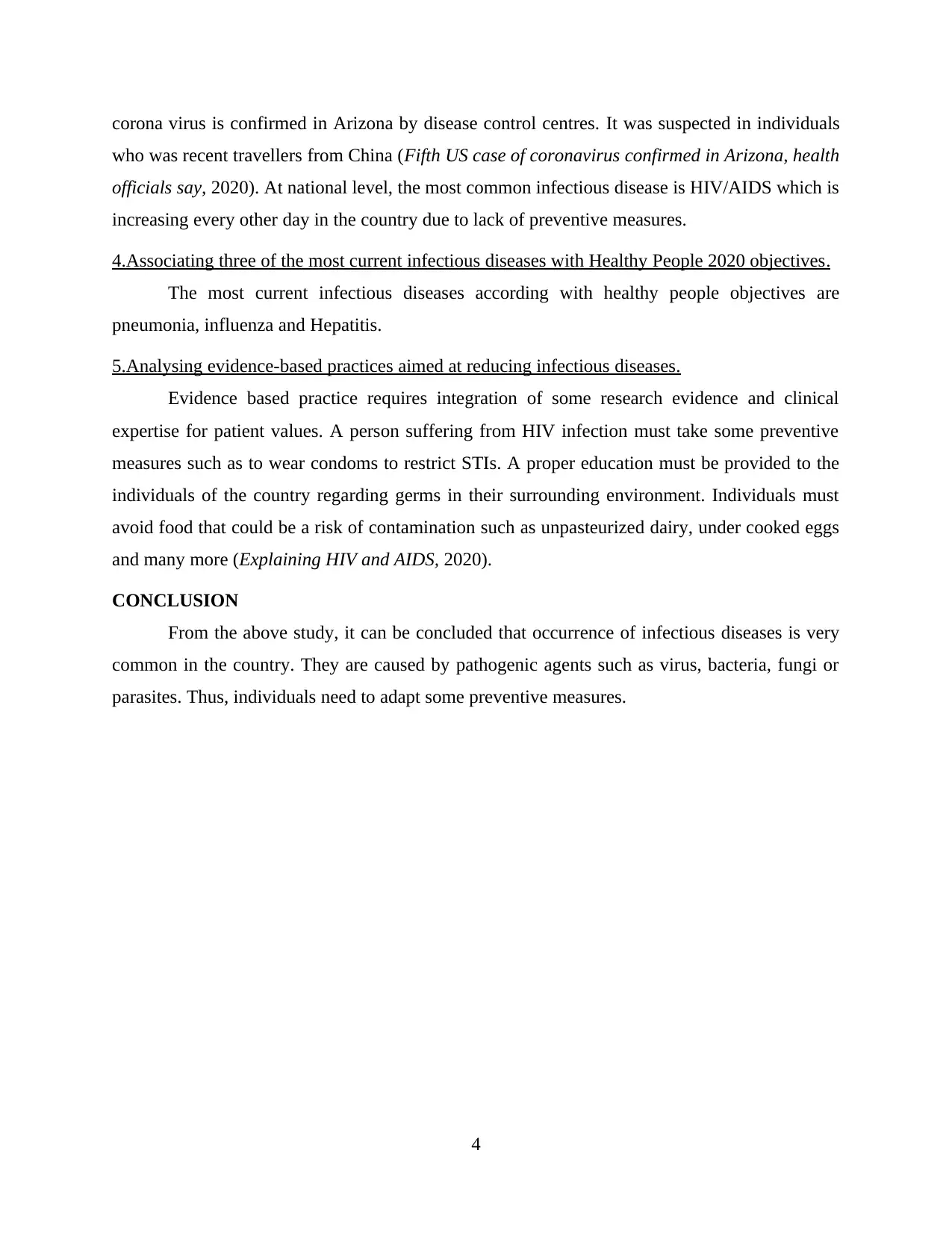
corona virus is confirmed in Arizona by disease control centres. It was suspected in individuals
who was recent travellers from China (Fifth US case of coronavirus confirmed in Arizona, health
officials say, 2020). At national level, the most common infectious disease is HIV/AIDS which is
increasing every other day in the country due to lack of preventive measures.
4.Associating three of the most current infectious diseases with Healthy People 2020 objectives.
The most current infectious diseases according with healthy people objectives are
pneumonia, influenza and Hepatitis.
5.Analysing evidence-based practices aimed at reducing infectious diseases.
Evidence based practice requires integration of some research evidence and clinical
expertise for patient values. A person suffering from HIV infection must take some preventive
measures such as to wear condoms to restrict STIs. A proper education must be provided to the
individuals of the country regarding germs in their surrounding environment. Individuals must
avoid food that could be a risk of contamination such as unpasteurized dairy, under cooked eggs
and many more (Explaining HIV and AIDS, 2020).
CONCLUSION
From the above study, it can be concluded that occurrence of infectious diseases is very
common in the country. They are caused by pathogenic agents such as virus, bacteria, fungi or
parasites. Thus, individuals need to adapt some preventive measures.
4
who was recent travellers from China (Fifth US case of coronavirus confirmed in Arizona, health
officials say, 2020). At national level, the most common infectious disease is HIV/AIDS which is
increasing every other day in the country due to lack of preventive measures.
4.Associating three of the most current infectious diseases with Healthy People 2020 objectives.
The most current infectious diseases according with healthy people objectives are
pneumonia, influenza and Hepatitis.
5.Analysing evidence-based practices aimed at reducing infectious diseases.
Evidence based practice requires integration of some research evidence and clinical
expertise for patient values. A person suffering from HIV infection must take some preventive
measures such as to wear condoms to restrict STIs. A proper education must be provided to the
individuals of the country regarding germs in their surrounding environment. Individuals must
avoid food that could be a risk of contamination such as unpasteurized dairy, under cooked eggs
and many more (Explaining HIV and AIDS, 2020).
CONCLUSION
From the above study, it can be concluded that occurrence of infectious diseases is very
common in the country. They are caused by pathogenic agents such as virus, bacteria, fungi or
parasites. Thus, individuals need to adapt some preventive measures.
4
Paraphrase This Document
Need a fresh take? Get an instant paraphrase of this document with our AI Paraphraser
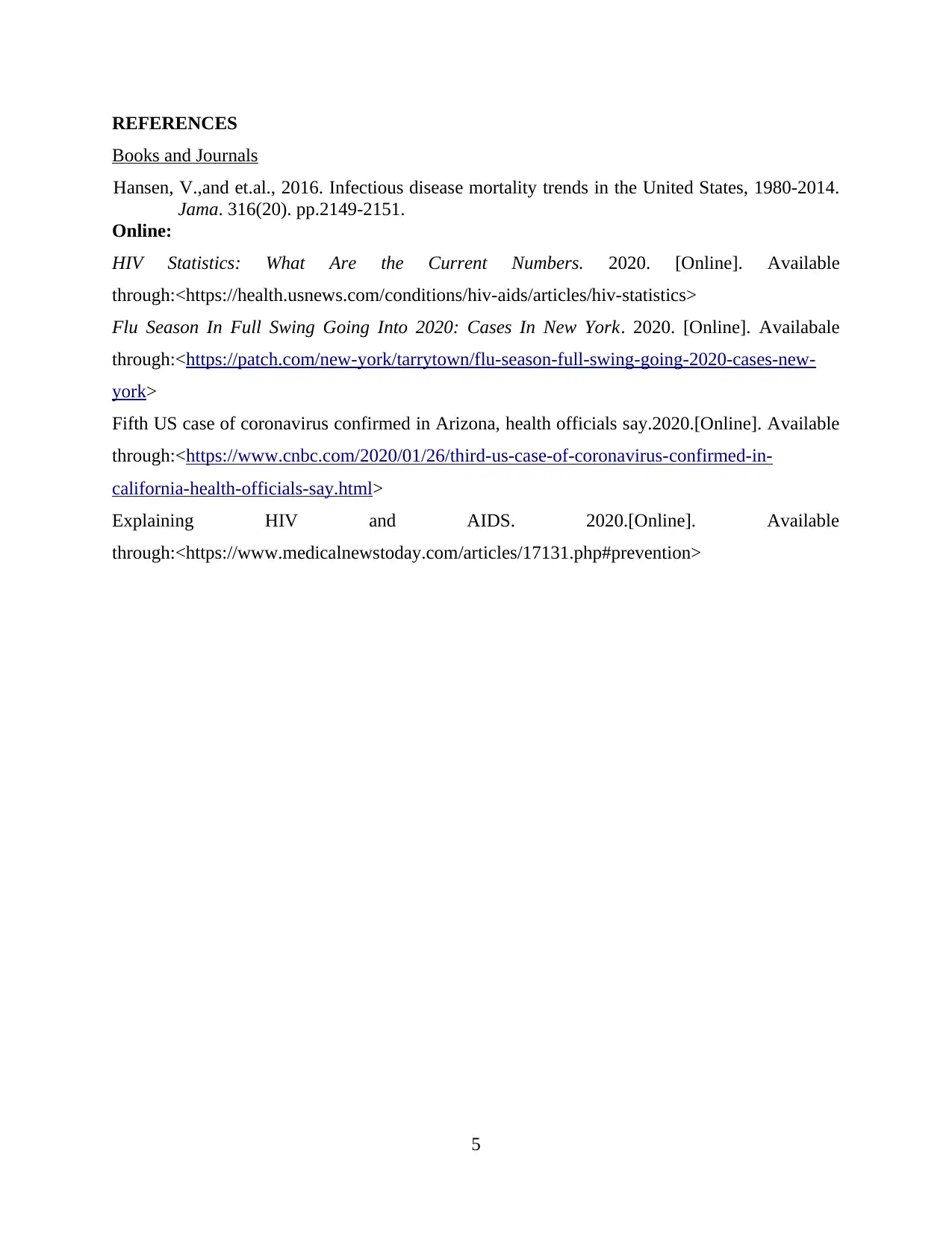
REFERENCES
Books and Journals
Hansen, V.,and et.al., 2016. Infectious disease mortality trends in the United States, 1980-2014.
Jama. 316(20). pp.2149-2151.
Online:
HIV Statistics: What Are the Current Numbers. 2020. [Online]. Available
through:<https://health.usnews.com/conditions/hiv-aids/articles/hiv-statistics>
Flu Season In Full Swing Going Into 2020: Cases In New York. 2020. [Online]. Availabale
through:<https://patch.com/new-york/tarrytown/flu-season-full-swing-going-2020-cases-new-
york>
Fifth US case of coronavirus confirmed in Arizona, health officials say.2020.[Online]. Available
through:<https://www.cnbc.com/2020/01/26/third-us-case-of-coronavirus-confirmed-in-
california-health-officials-say.html>
Explaining HIV and AIDS. 2020.[Online]. Available
through:<https://www.medicalnewstoday.com/articles/17131.php#prevention>
5
Books and Journals
Hansen, V.,and et.al., 2016. Infectious disease mortality trends in the United States, 1980-2014.
Jama. 316(20). pp.2149-2151.
Online:
HIV Statistics: What Are the Current Numbers. 2020. [Online]. Available
through:<https://health.usnews.com/conditions/hiv-aids/articles/hiv-statistics>
Flu Season In Full Swing Going Into 2020: Cases In New York. 2020. [Online]. Availabale
through:<https://patch.com/new-york/tarrytown/flu-season-full-swing-going-2020-cases-new-
york>
Fifth US case of coronavirus confirmed in Arizona, health officials say.2020.[Online]. Available
through:<https://www.cnbc.com/2020/01/26/third-us-case-of-coronavirus-confirmed-in-
california-health-officials-say.html>
Explaining HIV and AIDS. 2020.[Online]. Available
through:<https://www.medicalnewstoday.com/articles/17131.php#prevention>
5

6
⊘ This is a preview!⊘
Do you want full access?
Subscribe today to unlock all pages.

Trusted by 1+ million students worldwide
1 out of 6
Related Documents
Your All-in-One AI-Powered Toolkit for Academic Success.
+13062052269
info@desklib.com
Available 24*7 on WhatsApp / Email
![[object Object]](/_next/static/media/star-bottom.7253800d.svg)
Unlock your academic potential
Copyright © 2020–2025 A2Z Services. All Rights Reserved. Developed and managed by ZUCOL.





